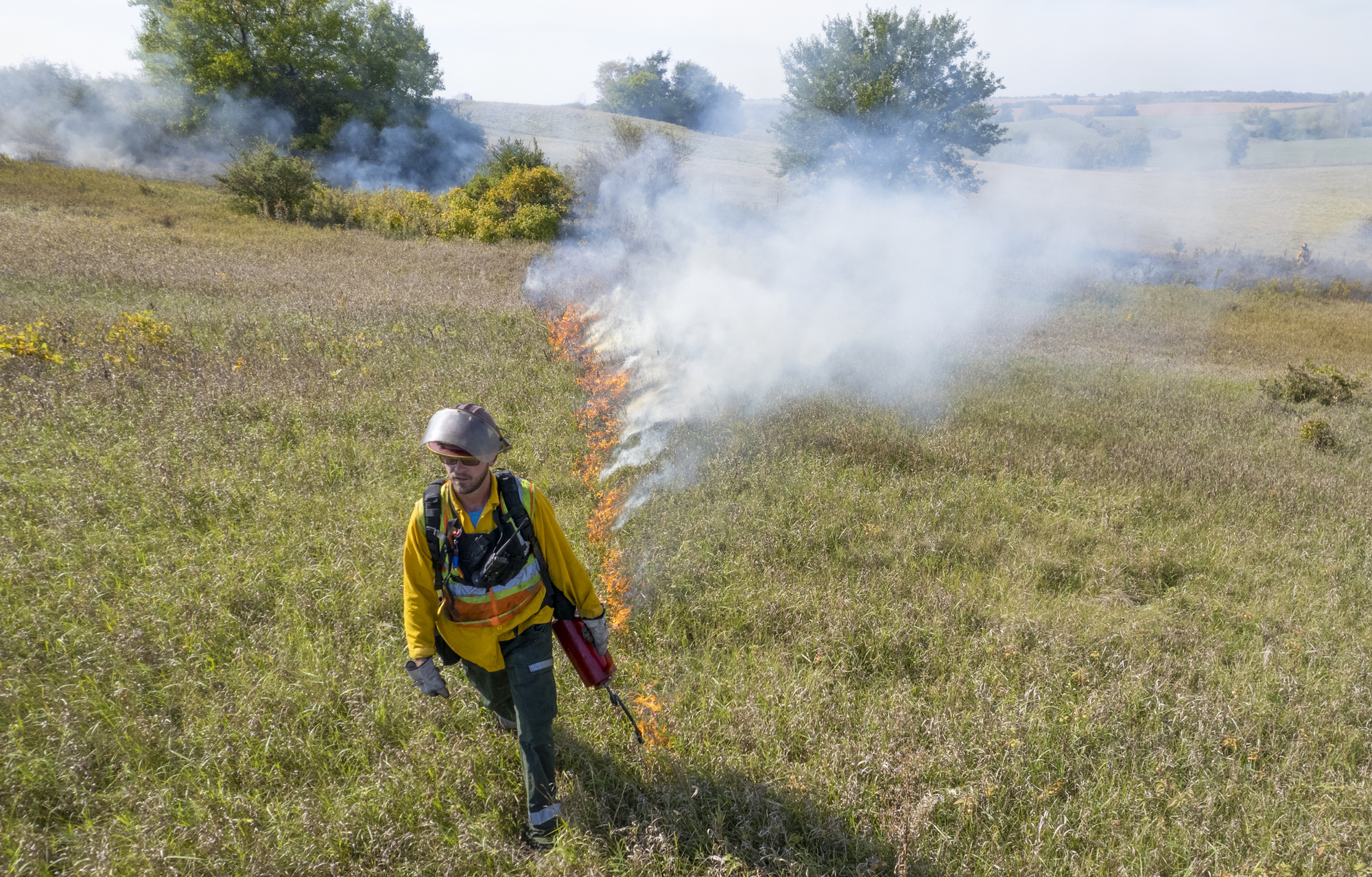Contact: Carly Lapin, DNR North Central Field Ecologist
Carly.Lapin@wisconsin.gov or 715-493-0991
DNR Increased Prescribed Burns During Late Summer
Burns Ignite Restoration Progress At Rare Northern Ecosystems
MADISON, Wis. – The Wisconsin Department of Natural Resources (DNR) increased prescribed burning during late summer to restore and maintain several state properties.
Prescribed burns are the intentional application of fire to a pre-planned area, under specific environmental conditions, to help conserve Wisconsin native grassland, wetland and savanna plant communities. Fire is a natural and necessary component of ecosystems such as native prairies, oak openings and pine and oak barrens. Periodic fire is required for regeneration and growth of fire-adapted species within these systems.
The DNR conducts prescribed burns to reduce wildfire fuels, reduce invasive plant species, stimulate wildflowers and grasses, control brush and improve habitat for local wildlife.
Prescribed Burning At Spread Eagle Barrens State Natural Area
The DNR increased use of prescribed burns at Spread Eagle Barrens State Natural Area in Florence County during native plant growing season in late summer.
Historically, prescribed burns have occurred in the spring at Spread Eagle Barrens and other State Natural Areas. As part of the DNR’s efforts to increase prescribed burns in the area, on Aug. 17, 2021, a prescribed burn was conducted to help maintain the state and globally imperiled bracken grasslands and pine barrens on-site.
“Our goal was to get 50% of the acreage in the planned area to burn, and we achieved nearly 60%,” said Carly Lapin, DNR Field Ecologist. “As a result, we hope that the barrens structure will improve, and plant diversity will increase as more growing season burns are implemented.”
In addition to Spread Eagle Barrens, DNR staff conducted growing season prescribed burns in late summer at Namekagon Barrens in Burnett and Washburn counties, Crex Meadows in Burnett County and at the Perry/Primrose Bird Conservation Area in Dane County.
The DNR does not plan to switch exclusively to prescribed burning during late summer growing season at Spread Eagle Barrens or other state properties. The department will use prescribed fire when it’s the right tool for management.
Spread Eagle Barrens Is Home To Globally Rare Ecosystems Dependent On Fire
Spread Eagle Barrens, a 7,155-acre State Natural Area managed in conjunction with We Energies’ Kingsford Dam project area, protects an extensive landscape of bracken grassland and pine barrens.
Spread Eagle Barrens also has several other natural community types important for rare animals, especially birds, butterflies, bees and other invertebrates, and common animals like turkey, deer and grouse.
Bracken ferns, sedges, brome and bluegrass dominate the grasslands. Pine barrens are a globally rare natural community type; about two-tenths of 1% of Wisconsin’s pine barrens acreage estimated in the early 1800s remains on today’s landscape.
Such natural communities evolved with fire and need it to perpetuate over time. Without fire, the structure and species composition of a plant community changes. As a result, invasive plants and woody species can overwhelm the site, and faster-growing species like maple can shade out slower-growing seedlings like oak.
Fire also removes accumulated leaf and grass litter and invading brush, stimulating the growth of native plant species and maintaining the open character of these systems. Prescribed burning also returns nutrients to the soil benefiting the entire plant community.

DNR burn crews conducting a prescribed burn at the Perry/Primrose Bird Conservation Area in Dane County. / Photo Credit: Michael Kienitz
Research Shows Benefits From Growing Season Prescribed Burns
An increasing number of studies across the upper Midwest including research conducted by DNR Research Scientist, Jed Meunier, suggests that spring may not be the most effective time to conduct prescribed burns to achieve brush control. In fact, some data show spring burning can cause up to a two-fold increase in re-sprouts on some of the woody plants targeted for control.
The DNR would like to continue conducting prescribed burns during the growing season for the following reasons:
- In spring, conditions can be too wet or dry to burn. Burning in the summer gives the DNR additional opportunities to use prescribed burns as a management tool. This shift in timing is important as climate change may reduce the chance to conduct burns during the spring.
- Burning in the summer ensures that wildlife species more sensitive to spring burns, including those whose young may be less mobile and at greater risk of perishing in spring fires, have more opportunities to thrive in the habitat they need and avoid direct mortality.
- Varying the timing of burning means that different species have a chance to respond after each burn, increasing plant diversity.
To determine if a summer prescribed burn is the right tool for the time frame, DNR field ecologists, forestry and wildlife management staff will identify a site’s known plant and animal species, especially rare species, to understand how a summer burn might impact them based on established avoidance dates or state/national guidelines. They will also assess potential issues related to smoke production from the fire during that time of year.
To view planned, current and past prescribed burns visit the DNR’s Prescribed Fire Dashboard.

